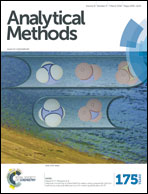Copper ion-selective fluorescent sensor using salicyl fluorone immobilized on a glutaraldehyde-coated eggshell membrane†
Abstract
A sensitive and selective quantification of Cu2+ by immobilizing a chromogenic agent on a chemosensor or biosensor has great significance in its scientific application. In this study, a kind of membrane sensor was applied to detect trace Cu2+ by immobilizing salicyl fluorone (SAF) and hexadecyl pyridine bromide (CPB) on a glutaraldehyde (GA)-coated eggshell membrane (ESM). In the presence of CPB, the fluorescence emission peak of SAF at 545 nm was efficiently quenched by Cu2+ through the formation of a ternary complex. The analysis conditions (e.g. SAF concentration, CPB concentration and pH buffer solution) were investigated to establish an optimized method. The membrane sensor (SAF/CPB-GA-ESM) had a linear working range of 5–500 ng mL−1, while the detection limit for Cu2+ was 0.5 ng mL−1. Compared to the detection of Cu2+ in aqueous media, the membrane sensor exhibited the advantages of low detection limits, high sensitivity and selectivity, as well as excellent stability. This fluorescent sensor was also successfully applied to the detection of Cu2+ in water samples.


 Please wait while we load your content...
Please wait while we load your content...